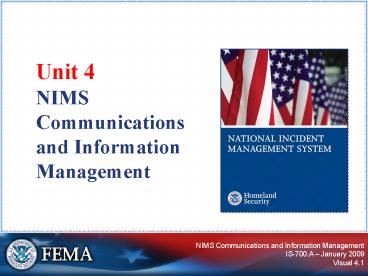NIMS Communications and Information Management - PowerPoint PPT Presentation
1 / 20
Title:
NIMS Communications and Information Management
Description:
of communications and information management. ... How do you ensure that communications systems are reliable, scalable, and portable? ... – PowerPoint PPT presentation
Number of Views:112
Avg rating:3.0/5.0
Title: NIMS Communications and Information Management
1
Unit 4
- NIMS Communications and Information Management
2
Unit Objectives
- Describe the importance of communications and
information management. - Define the concepts of common operating picture
and interoperability. - Describe the purpose of communications and
information management standards, procedures,
and protocols.
Unit List
- Overview
- Understanding NIMS
- Preparedness
- Communications and Information Management
- Resource Management
- Command and Management
- Additional Resources and Course Summary
? See pages 23-30 of the NIMS document.
3
What Is NIMS Communications Info Management?
Click on the image to start the video.
4
Flexible Communications and Information Systems
5
Common Operating Picture
- A common operating picture
- Is established and maintained by gathering,
collating, synthesizing, and disseminating
information. - Allows on-scene and off-scene personnel to have
the same information, including - Availability and location of resources.
- Status of assistance requests.
6
Interoperability
- Emergency communications systems should
- Be the same or linked to the same system used
for nonemergency procedures. - Effectively interface with national standards.
- Allow data sharing among key players.
7
Interoperability Saves Lives!
- Consider the differences between the responses to
the following incidents - 1982 Air Florida Flight 90 crash
- September 11, 2001, terrorist attack on the
Pentagon
8
Reliability, Portability, Scalability
- Communications systems should be
- Reliable able to function in any type of
incident - Portable deployable to different locations
and compatible with other systems - Scalable suitable for use on large or small
scale
9
Resiliency and Redundancy
- Communications systems should have
- Resiliency ability to perform after damage or
loss of infrastructure - Redundancy duplication of services or the
ability to communicate through diverse,
alternative methods
10
Activity
- Instructions
- Work with your group to answer the questions
below. - Select a spokesperson and be prepared in 5
minutes. - Questions
- What steps have you taken to ensure a common
operating picture among response partners? - What interoperability challenges have you faced
and how have you addressed them? - How do you ensure that communications systems are
reliable, scalable, and portable? - What are some best practices for ensuring
communications systems are resilient and
redundant?
11
Standardized Communications Types
- Successful communications and information
management require the use of - Strategic communications
- Tactical communications
- Support communications
- Public address communications
12
Policy and Planning
- Communications plans should identify
- What information is essential and can be shared.
- Who . . .
- Needs the information.
- Has the information.
- How . . .
- Information will flow.
- Information is coordinated for public and media
release. - Communications systems will be used.
13
Agreements
- Agreements should
- Be executed among all stakeholders.
- Specify communications systems and platforms to
be used.
14
Equipment Standards and Training
- Standards should address
- Conditions under which communications systems
must operate - Maintenance and updating of systems and
equipment - Periodic testing of systems
15
Incident Information
- Information may provide for
- Development of incident objectives and Incident
Action Plan (IAP) - Identification of safety hazards
- Determination of resource needs
- Formulation of public information messages
- Analysis of incident cost
16
Communications and Data Standards
- Standards may include
- A standard set of organizational structures and
responsibilities. - Common typing of communications resources.
- Use of agreed-upon communications protocols.
- Common identifier titles for personnel,
facilities, and operational locations.
17
Plain Language Common Terminology
- Plain language
- Is a matter of safety.
- Facilitates interoperability across
agencies/organizations, jurisdictions, and
disciplines. - Ensures that information dissemination is timely,
clear, acknowledged, and understood by all
intended recipients.
18
Discussion Questions
What challenges has your organization faced in
incident communications?
What are the benefits of using plain language
during an incident?
19
Knowledge Review and Summary
- Instructions
- Answer the review questions on the next page in
your Student Manual. - Be prepared to share your answers with the class
in 5 minutes. - If you need clarification on any of the material
presented in this unit, be sure to ask your
instructors.
20
Preparedness Self-Assessment
- Instructions
- Turn to the self-assessment in your Student
Manual. - Take a few moments to complete the checklist
about your organizations communications and
information management systems. - Use this information later to help strengthen
your organizations response capabilities.































